
This review, “Easy imaging for everyone,” appeared in the June 2005 issue of Astronomy magazine.
What if I said you could create images like these your first night under the stars? Would you call me crazy? Read on …
“I can’t do this!”
Not so long ago, amateur astrophotography was reserved for those who had unlimited patience and deep pockets. Even after the introduction of a small silicon wafer called a charge-coupled device, or CCD, it seemed time, experience, and money were still keys to achieving satisfactory results when imaging celestial objects.
To top it off, anyone who was interested in trying astrophotography faced an array of costly CCD cameras and seemingly endless choices of image-capturing and processing software. Meade changed all that.
In 2003, Meade introduced the Lunar Planetary Imager (LPI). This easy-to-operate $150 CMOS camera (CMOS is the type of chip used — a complementary metal oxide semiconductor) introduced a simpler form of astroimaging to those who previously had been overwhelmed.
To continue reading this review you need to be an Astronomy magazine subscriber.
Subscribers have full access to our equipment review archive and many other great online benefits.
Already a subscriber? Simply log in or create an account below.









